The most beautiful places to visit in the Greek mainland
Greece is full of natural beauties, landscapes and places so beautiful that they look like paradise on earth they prove the greatness of nature, places of otherworldly beauty, well-known inside and outside the borders, and other well-kept secrets. In any case, the Greek landscape on its mainland has a magic and unique quality that makes it so special.
Greece is one of Europe’s top tourist destinations, renowned for its ancient myths, amazing landscapes and deep blue waters. There’s something for everyone here: from sun-kissed beaches to rugged mountain ranges, vibrant cities to quiet villages – explore ruins or relax on the beach! To help you plan your perfect Greek getaway, this blog post has compiled a list of the best 30 places to visit divided by regions. Be dazzled by the beauty and charm of this Mediterranean paradise – from the bustling streets of Athens to the serene wilderness of Epirus. Whether you’re looking to immerse yourself in history or simply enjoy a laidback beach vacation, Greece has plenty to offer!
If you’re looking for luxury and relaxation, the Cyclades are perfect for you. Families will love exploring Zakynthos and other family-friendly destinations in the Greek islands.
The Greek mainland offers so much more than just Athens, from mountain ranges like Meteora to historic sites like Delphi and Olympia. A true testament to Greece is its people – warm, welcoming individuals who are eager to share their heritage with visitors. It doesn’t matter if you’re planning your first trip or returning for another adventure, take the time to connect with locals!
Prepare for an unforgettable experience in one of Europe’s most captivating countries – Greece!
Best places to visit in Epirus
Ioannina
Student rhythms, an old town inside the castle, one of the most beautiful in Greece and dozens of options for excursions outside. A weekend in Ioannina means, first of all, walks inside the castle, on the waterfront and on the island. These are the most picturesque parts of the city, while the most nerve-wracking point of the nightlife is the streets around the waterfront and those in the center.
But it is worth exploring the rest of the city as well: buy a bagatsa from the cult bagatsadikas on Averof Street, wander the Saturday street where various grandmothers carry their zarzavats from the village, look for the lost charm in the Gliss kafene district (the old shopping district). For boiled soup and a 180° view, finally, climb up to the village of Ligiades, the best balcony for Pamvotis lake.
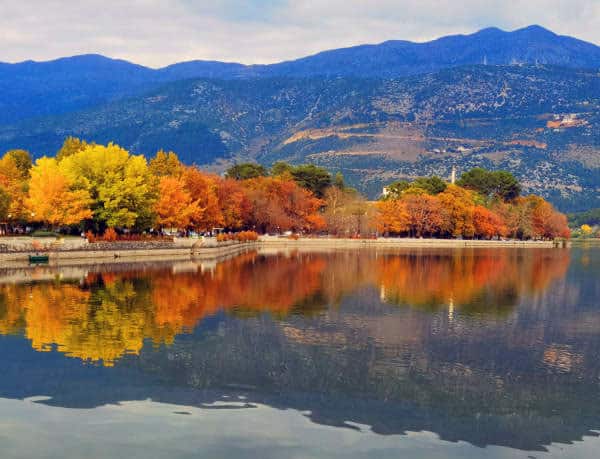
Tzoumerka
Arachthos welcomes us without the bridge of Plaka joining its banks, while in the background the hard bare peaks of the Athamani mountains create a unique complex – like a natural sculpture of enormous dimensions. Tzoumerka may not be unknown anymore, but they maintain a lower profile that captivates mountain lovers.
Highlight villages here are Kalarites and Sirako. Both beautiful and stone-built, they deserve to compete with even the most picturesque of Zagorochoria. Infrastructure has been built up in recent years, so you’ll find something to nibble on even on the coldest winter days. On the other side of the river we find Pramanta, Melissourgou and Katarraktis. Top experience, finally, rafting on Arachthos – considered one of the most difficult rivers, but the experience is unrepeatable.
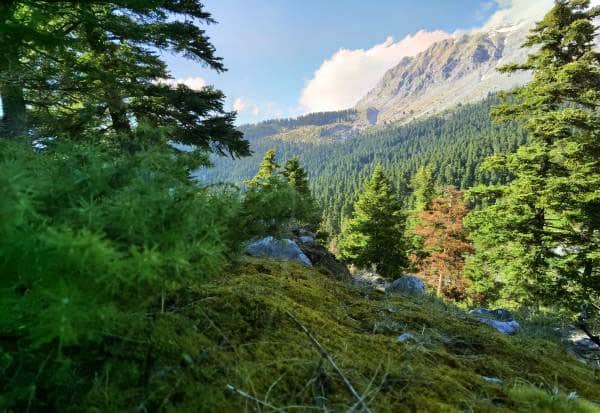
Zagori and Papigo Epirus
The two famous villagges of Zagori, Big and Small Papigo, at an altitude of 980 m. The first and 1,040 m. The second, with only 4 km distance between them. With the imposing Astraka mountain embracing them like a guardian angel and natural swimming pools, Ovires Rogovo, ideal for diving between smooth slate slabs, the scenery is special all year round and one of the most beautiful places in Greece.
The image is completed by well-preserved stone buildings of traditional Zagorian architecture and cobbled streets that lead to chapels and fountains.
Megalo Papigo, one of the most beautiful traditional settlements in the country, is the most developed, with many options for accommodation, food, coffee and drink, and attracts many travelers, from nature lovers and families to couples and groups.
In Mikro Papigo the car stops at the entrance of the village and the hiking routes start leading to Drakolimni (Dragon Lake) inTymfi mountain. Those who love tranquility will prefer it, as it also has some beautiful hostels. It is necessary to visit the WWF Information Center that operates in the village.
When to go: Autumn and spring are the most beautiful seasons. In September and October, the months when birds migrate and fanatical bird watchers gather here.
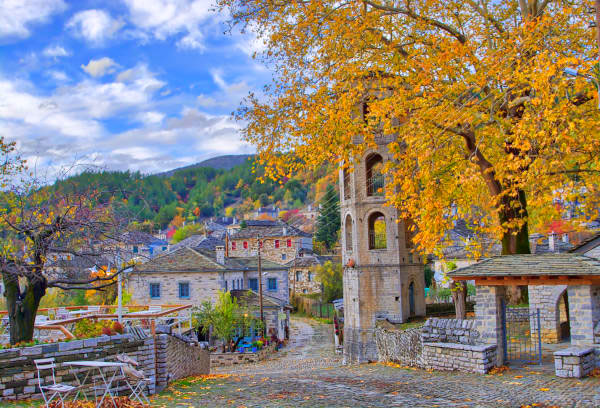
Zagorochoria
It is impressive how such a remote area of Greece managed to establish itself as a constant highlight of our travel excursions. As soon as the first rains fall and the chimneys of the stone houses of Zagori begin to smoke, the convoy of the Athenians starts.
October in Zagori: the fog covers the steep ravines of Vikos, the plane trees on the banks of Voidomatis shed their leaves, the wild grasses “surround” the centuries-old stones of Skala tou Vradetou (perhaps the most beautiful cobblestone in mountainous Greece).
During the day we look for the most beautiful “balconies” overlooking Viko, test the endurance of our car driving to Gyftokambos or simply relax next to the natural swimming pools of Papigo. And when dusk falls, we make appointments at well-known and favorite spots for coffee and food.
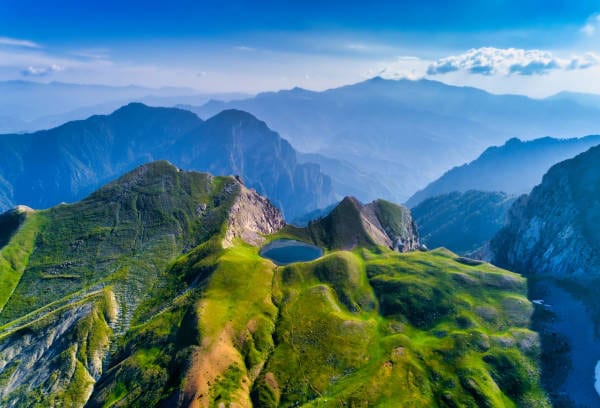
Dragon Lake Mount Tymphi
Drakolimni of Tymfi is about 1 hour’s walk from the organized shelter in Astraka’s saddle and a total of 4 hours’ walk from Mikro Papigo. Access is only possible on foot.
Folk legend stated that the alpine lake was bottomless, impassable, and that it hid untold treasure there. In its waters lived a terrible dragon who with stones and logs tried to exterminate the rival dragon of Smolika’s Drakolimni.
White rams were created from the stones of Tymphi’s dragon and black sheep from the logs thrown by Smolika’s dragon. At some point the two herds met, but their offspring were unlucky and all drowned in the icy waters.
Another interpretation of the legend says that since the stone war of the two dragons, the banks of the dragon lake of Smolika are white with scattered black stones, while the banks of this Tymphi are black with scattered white stones.
About the depth of the lake there is another interesting legend that refers to the years of Turkish rule. Then a Bey sent a skilled swimmer from Preveza to dive and measure its depth. He remained in the water for some time, and when he emerged, terrified, he gave orders that no one should attempt the same venture. The actual depth of the lake does not exceed 3-5 meters, depending on the season and the waters it receives.
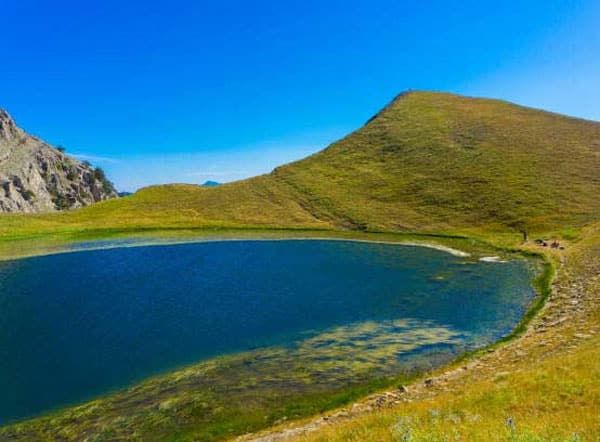
Best places to visit in Peloponnese
Monemvasia
Within the medieval walls of Monemvasia in Peloponesse Greece, is one of the most well-preserved and vibrant castle cities in Greece, which attracts fanatical visitors all year round. Dozens of churches, mansions of wealthy merchants, fountains, Turkish baths and winding cobbled streets are kept in remarkably good condition, preserving the atmosphere of this settlement, which from the Byzantine years to the 19th century played an important role in the history of the region.
There is no car inside the castle, so get ready for a walk. The main cobbled path that starts from the gate of the Castle leads you to the most important sights but also to the restaurants, bars and shops that are gathered along it. From the central square with the cannon, the church of the Dragged Christ and the Archaeological Museum begins the cobbled path to the Upper Castle or Goula, the second settlement. It is worth the uphill between the pomegranates and the date palms and only for the view from the walls of the Upper Castle, in front of the imposing church of Agia Sofia, but unfortunately at the moment the Upper Castle is closed for maintenance.
The hotels inside the Castle are small hostels housed in old, listed buildings. The new town, Gefyra, is no different from any newly built seaside resort, except perhaps for the fact that it offers views of the Castle. You will find everything: hotels, taverns, shops, patisseries, banks. Its sandy beach is very popular.
When to goWhen to go
Monemvasia Castle never leaves the agenda of weekenders. Except in summer, however, things are more relaxed, as the large groups that come for a day trip are missing and the visitors are mainly couples. Easter has a special color.

Nafplion
Probably the most charming city of the Peloponnese and one of the favorite places for weekends all seasons in Greece. In the puppet old town of Nafplion, with the preserved architectural physiognomy and the two Venetian castles that crown it, Akronafplia and Palamidi, the aura of the first capital of the Greek state is diffused.
Admire the city from above by climbing the -999 according to tradition 857 according to others- steps that lead to the imposing Palamidi which stands on a huge gray rock and overlooks the sea. From Akronafplia the view of the city is equally impressive, while if you follow the pedestrian street of Arvanitia that surrounds the rock of Akronafplia, you will take an idyllic walk with the sea under your feet. In restored mansions, scattered in the old town of Nafplion, you will find beautiful guesthouses.
The core of the old town stretches behind the shores of Bouboulina and Miaouli promenades, which are full of cafe-bars and taverns with a wonderful view opposite Bourtzi, the small island with the Venetian fortress of the same name.
The main pedestrian street of King Constantine will become a reference point in every tour of the old town, as it crosses almost the entire and ends at the cobbled Syntagma Square, the meeting point that is strongly reminiscent of Italian piazza.
Here is the Archaeological Museum, the Parliament that housed the first parliament of the free Greek state and the Old Mosque.
The traditional taverns occupy the entire length of Staikopoulou Street (parallel to V. Konstantinou), at the end of which is the Kombologiou Museum. The alleys around this road offer to get lost: they are full of Turkish fountains and Turkish baths – memorabilia of Turkish rule – and historic churches. The two green parks, of Kolokotronis and OSE, which welcome visitors at the entrance of the city, are suitable for stressful walks.

Kalavrita Peloponnese
The mountain town attracts a eclectic crowd. On the one hand, the classic tour buses that fill the tourist taverns and on the other hand, the colorful young crowd that overwhelms the cafes of the central pedestrian street (the shops are fine, although our eternal love remains the cafe of the railway station).
Walkers test their stamina in the Vouraikos gorge, families go trout fishing in the plane tree forest of Planeteros. That is until the first snow falls, at which point the ski resort with its large wooden chalet claims the lion’s share.
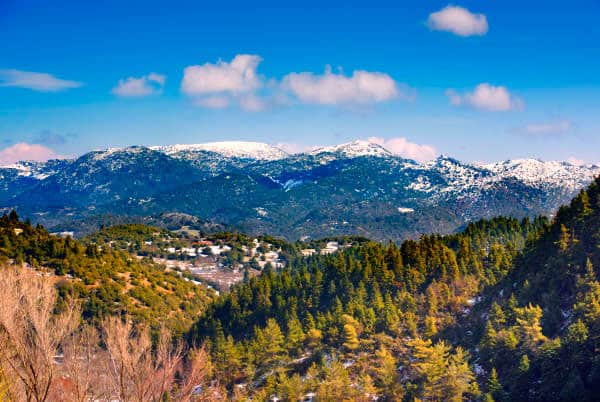
Ziria Peloponnese
140 km from the center of Athens, to enjoy the fir trees of Ziria and the grills of Middle Trikala. But what excites us in the area is the network of dirt roads that offer dozens of tours on the Ziria plateau. The tiny Dasio lake is the top destination: fir trees surround its shores creating a backdrop for elves. Hopefully it doesn’t rain the night before, because the road gets muddy easily and becomes impassable.
If you have a vehicle with four-wheel drive, the possibilities are even more. cross the entire plateau and depending on the mood of the moment turn to Goura (then you will fly to Stymphalia) or to Zarouchla, in which case you will also pass by Feneos with the artificial lake of the Dam of Glory and the old monastery of Agios Georgios.

Elafonissos
The beach of Simos is perhaps the only, but by no means insignificant reason to cross the laconic land with the final destination being the small island at the southeastern tip of the Peloponnese. This exotic strip of land with its turquoise waters, white dunes and cedars has sworn fans flooding the exemplary beach campsite every summer and they are definitely annoyed by the ever-increasing sun loungers or the big nightclub that has been operating in recent years in Simos.
The truth is that this island of 19 sq.km. seems not to like a lot of fuss. Besides, here you will come for heavenly baths and a walk in the picturesque port, which is the only organized settlement, with the beautiful beach and the colorful boats that supply the few taverns with fresh seafood. In its center a small peninsula is formed where the church of Agios Spyridon dominates, a favorite place for hang-out of the younger ones who, when it gets dark, go there with beers and even your laptop, since the place provides free wi-fi. Few hotels and rooms for rent are offered for your stay in case you do not like camping, while remember to have enough cash because the only ATM on the island may not work when you need it.

Best places to visit in Thessaly
Meteora
The almost eerie stone cliffs of Meteora, which hug Kalambaka, are a Preserved and Protected Monument of Humanity by UNESCO and the largest monastic state in the country after Mount Athos. At a distance of about 25 km from the city of Trikala, the “tectonic horns” formations, according to geologists, were created between the Koziaka and Antichasia mountains about 30 million years ago when the sea covering the area began to recede, dragging and piling rocks on the bottom, which over the years stabilized.
Just look at the stone volumes shrouded in mist and you will understand what led the monks to seek solitude here 1,000 years ago. Today, of the many monasteries of Meteora, only six are operating: Agios Nikolaos Anapavas, Metamorfosis tou Sotiros or Megalo Meteoro, Varlaam, Roussanou, Agia Triada and Agios Stefanos. The nearby town of Kalambaka is both an organized tourism attraction, with decent hotels, rooms and campsites, and a world-class climbing destination (Doupiani or Doupiani is the most famous climbing area and the chapel of the Virgin Mary at its base was the first center of organized worship monasticism).
Within its anarchic structure it hides traditional workshops of iconography and woodcarving and its most picturesque part is Kastraki, which now joins the city. Kalambaka is an ideal base for walks in the villages of Aspropotamos and the mostly Vlach-speaking villages of the area.
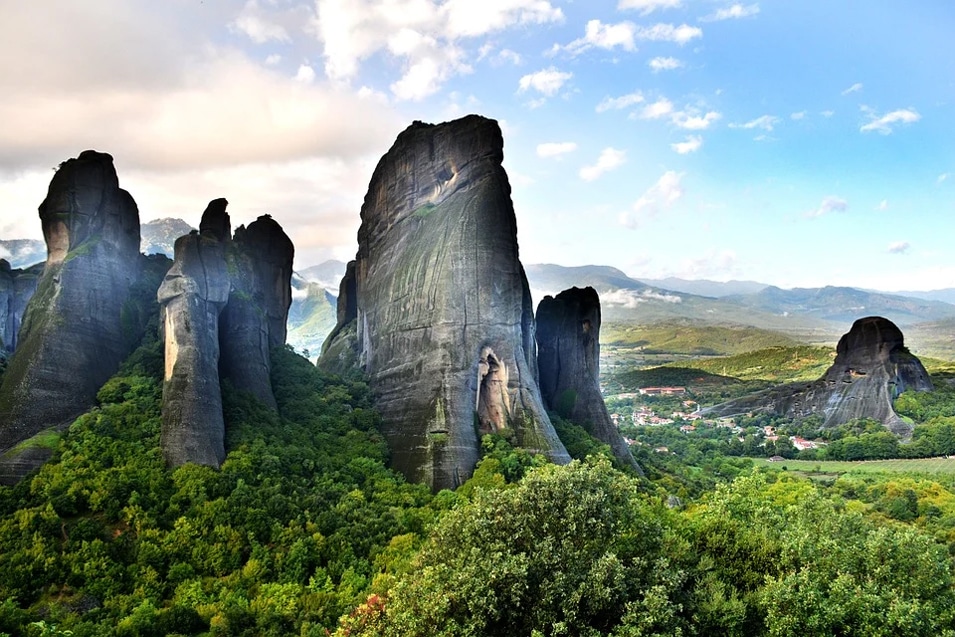
Lake Plastira
Perhaps the most beautiful sunset in mountainous Greece – regardless of the 340 kilometers we need to travel to enjoy this magical moment when the sun disappears behind the peaks of the Agrafa, the fjords darken and the waters of the lake take on an eerie blue color. This weekend is extremely dedicated to the water element.
In the mornings we walk along the shores of the lake, on the beaches of Kalyvia Pezoulas or Lamperos. We rent bicycles and carve our own routes in the lakeside areas, we arrange a ride with the horses of the Equestrian group or even by canoe-kayak. In the afternoons we enjoy the view from Neochori.
The balcony of the classic Agnadi tavern is one of the best spots for… lake-seeing. Those with ecological quests get information about the flora and fauna of the area from the Environmental Information Center, while the rest wait for them at the Artemis cafe (Neochori), snacking on sandwiches and listening to music, or choose an excursion to the trout farm of Karitsa.
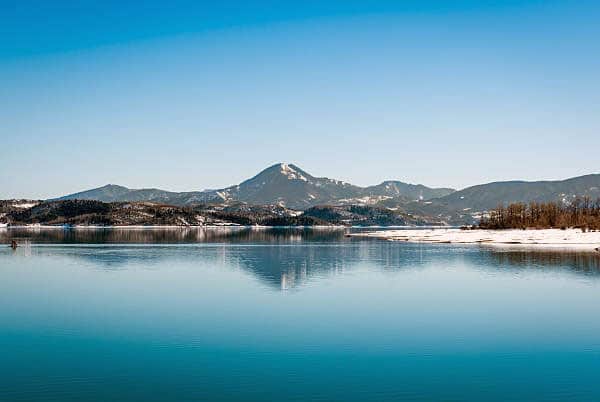
Pelion
Pelion’s stone squares and tsipouro in the winter sunshine, routes through plane trees with a view of the sea, an orphaned chicken at the Old Station in Milies, dishes with wild mushrooms in Tsagarada, horse riding in Argalasti. Classic, beloved, well-travelled, Pelion is a mountain which may still surprise us.
Each village has its own lifestyle. Makrynitsa and Portaria are the closest villages to Volos, in fact they form its balcony. Milies and Vyzitsa are stable values – especially the latter is famous for its mansions that have been converted into guesthouses.
Tsagarada and Zagora highlight in the most representative way the profile of eastern Pelion with its wild vegetation and the view of the wonderful beaches of the Aegean. Finally, Argalasti and Lafkos are the sweetest and Mediterranean version of the mountain, with endless olive groves, the “lake” view of the closed bay of Pagasitikos and the calm rhythms.
Of course the villages are not exhausted in this first description. Have an appetite and the odometer of your car can write endless kilometers, as you will explore its dozens of settlements, from Chania on the ski slopes to the “island” Trikeri on the tip of the peninsula.
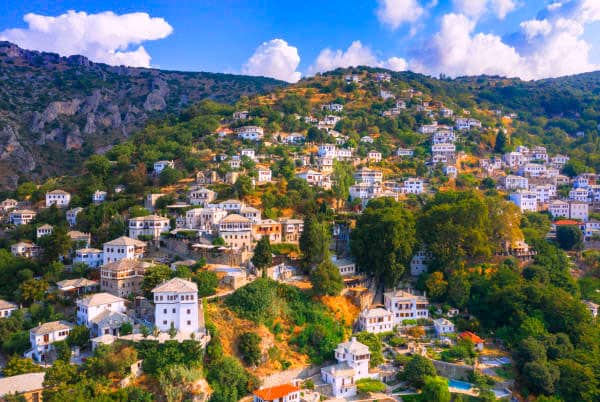
Best places to visit in western Greece
Agrafa villages
In South Pindos, the area of Agrafa full of pristine routes is one of the last strongholds of the nature lovers. The best way to get to know it is by 4×4 or on foot. We do not know if Agrafa really took its name from the time of the Byzantine Empire when due to the location and character of the inhabitants the collection of taxes was impossible with the result that the area is not recorded in official documents.
What is certain is that even today you have to cross a wild landscape in the valley of the Agrafiotis river and drive on a dirt road to get here; the village of Agrafa is 90 km from Karpenisi, of which the last 26, from the village Krenti and then it is dirt road. Beyond that, however, lies the real challenge that can be enjoyed by those who have a 4×4 and definitely hikers.
The area does not have the tourist development of the rest of Evritania. It has a few but decent hostels and remains an attraction for climbers and lovers of alternative tourism who enjoy rafting in Tavropos and kayaking on the artificial Lake Kremasta. The village of Agrafa dominates the area, it is the largest, with hostels, taverns and cafes.
From here leaves a road that connects Evritania with Lake Plastira. Each of the small villages has its own history and the locals will be happy to tell it to you while drinking a tsipouro in the cafes: Marathos with the stone-built church of Taxiarches of the 16th century, Epiniana an ideal starting point for mountaineering routes, Tridentro, built on the right bank of the river Agrafiotis with a plane tree-natural monument, Trovato with the small church of Ag. Dimitrios build in 1641, Braggiana with the School that operated until 1662 and Monastiraki with the churches of Panagiaand Agios Dimitrios.
When to go : Definitely before the rains start. From May to August is an ideal time to combine your excursion with alternative activities.

Karpenisi
Dazzled by the twists and turns of Timphristos, we drink our first coffee in the central square of Karpenisi. Musical background is the wind between the dry leaves of the plane trees, the conversations of the locals and, phew, the growling of the cars that leave in a hurry for the valley of Karpenisiotis.
Mikro and Megalo Chorio and Koryschades are the most beautiful villages on the route and their neat guesthouses make us prefer them for accommodation in the valley. But Evrytania does not end here. Equally classic, although not as crowded, are the routes to Krikelos and Domnista or, in the opposite direction, to Vinianis and Fragistas, the villages of the lake, as the expanse of water of the artificial lake of Kremasto stretches nearby.
Evrytania insiders recommend Fidakia, the village with the most panoramic view of the lake. If you have a jeep, you will also attempt an entrance to Agrafa. Weather permitting, you will have the opportunity to get to know the entire network of dirt roads that ends in the Prefecture of Karditsa and Lake Plastira. Unique on the road experience. Yes, this is the secret of Evrytania: high-quality luxury and at the same time untouched off-road beauty..

Vardousia
Going up the winding road to Vardousia, the sound of the engine sounds foreign to you. Side, in front, behind you, everywhere, all ravines, greenery, running water and imposing wooded slopes. The climbers who make an appointment with Athanasios Diakos (Mousunitsa) know something and at every opportunity they make their way to the top.
Of course, you can soak up the scenery in a more leisurely way, walking through the alleys of the village or taking a short route on the E4 hiking trail. And in the evening, the meat-eating balm in the taverns of the square. But Vardousia is not only the now famous Mousounitsa. On the back side of the mountain, a handful of small villages, watching the flow of the Mornos from above, also claim a share in your excursions. Pentagioi, the stone village of Maria Pentagiotissa, is dolled up.
Mountainous Nafpaktia
Those who want to add an idea of adventure to their winter weekend make their way to mountainous Nafpaktia. Beautiful, with its well-preserved castle, Nafpaktos can hold you for a while with its attractions, that is, until its mountain villages blow your mind. Larger and better known are Elatou and Ano Chora, immersed in fir and chestnut trees.
Although they have been on our travel agenda for several years, they have not taken off in terms of tourism, maintaining their low profile. You will walk in the forest, you will try local flavors in the village taverns, you will be drawn into tsipouro situations with the locals, you will love the off road routes.
Macedonia and northern Greece
Apart from the capital of Macedonia, Thessaloniki, there are many beautiful cities and sights to see in Macedonia, some of the most importent are listed here.
Kastoria built on the banks of Lake Orestiada, with its narrow streets pulsating with life, its old wooden houses and mansions, and its fur factories and workshops. its particularly beautiful in the spring and fall.
Florina. a pretty town, spread out on the slopes of a hill covered with wild chestnut trees, is a good starting point for a visit to the wildlife sanctuary at Prespa.
Thessaloniki
Thessaloniki is the second-largest city in Greece and one of the most vibrant cities in the country. It is located on the Thermaic Gulf and has a rich history dating back to ancient times.
The city’s main attraction is its impressive Byzantine heritage, which can be seen throughout its architecture and landmarks. One such landmark is the UNESCO World Heritage site of Hagia Sophia, a stunning 8th-century church that was converted into a mosque during Ottoman rule.
In addition to its historical significance, Thessaloniki also boasts a bustling nightlife scene with numerous bars, clubs, and restaurants. The Ladadika district is particularly popular for its lively atmosphere and traditional taverns serving delicious local cuisine.
Visitors can take a stroll along the waterfront promenade or visit one of Thessaloniki’s many museums, including the Archaeological Museum showcasing artifacts from prehistoric times to late antiquity.
Thessaloniki offers visitors an authentic taste of Greek culture with plenty of sights to see and experiences to enjoy.
Metsovo
Coaches jostle down the main street of the village, the hotels are always a bargain, while the countless visitors stock up on metsovone in quantities, browse the folk handicrafts, try a different kontosouvli every night in the village taverns and end the day with a drink in the cafe-bars of the main street. But Metsovo has a soul, which manages to survive in this folklore environment.
In the central square, or alun as it is called in Vlach, the old Metsovites hang out on the benches, always wearing their traditional costumes. The first time you see the sight, you think it’s some kind of attraction, as right next to it are the souvenir shops with the fashion glitz.
The old people were completely indifferent to the tourist noise of the square, they chatted among themselves in low voices and even in their local dialect. Then you understand that in Metsovo a truly admirable combination has been achieved, folklore and living tradition coexist, support each other and somehow create an authentic whole, even if most of the buildings are new (“roughly” traditional).
Walks on the slopes of the village with necessary stops at the Metsovo art gallery, the park of Agios Georgios, a grove with all kinds of trees found in Pindos, the cheese factory and the winery of Averof. Just outside the village, in a ravine, awaits us the historic monastery of Agios Nikolaos with frescoes from the 17th century. The walk, however, which should not be missed, requires a car and takes you to the artificial lake of Aoos (20 km from the village).
Elatochori Pieria
Perched in eastern Pieria, it is today a complete tourist resort, ideal for excursions all year round. In winter snow lovers will find one of the most beautiful small ski resorts in Greece just 8 km away, in spring nature lovers gather here due to the wonderful nature, while in summer it is always cool due to altitude and at the same time very close to the coast of Pieria .
The lush forest that surrounds it and the abundant view of Mount Olympus act as a magnet for visitors, both for those who seek relaxation close to nature and for those who love adventure, since – in addition to winter sports – has many hiking trails. and mountain biking as well as forest roads for exploring with 4×4 cars. The village, which is built at an altitude of 800 m, is divided into two settlements, Paleo and Neo Elatochori.
The first is experiencing remarkable tourist development, with well-kept stone guesthouses, modern and luxurious mountain resorts, rooms to let, taverns, cafes and stylish bars. Finally, it is worth visiting the historic church of Agios Nikolaos with its magnificent wood-carved iconostasis and ornate paintings.
Mikri and Megali Prespa lakes.
Situated at analtitude of 850 metres. these two lakes are separated by a narrow strip of land The banks of Mikri(Small) Prespa are thick with reeds, an ideal cover for the numerous species of birds that nest there every year.
In the middle of the lake floats the islet of Agios Ahilios with ancient and Byzantine remains. Its rocky coast contains caves with shrines and religious paintings.
On the coast of Megali (Great) Prespa, which varies between being steep and rocky and serene and lush, there is a picturesque little village called Psarades, looking as though it belonged on an Aegean island. Here and on Agios Germanos, where there is a Byzantine church dedicated to that saint, you will find tavernas serving fish caught in the lakes.
Using Grevena, a small town built on the banks of two small rivers, as a base, you can visit the exquisite Greveniot Pindos mountains, its villages of Deskati, Zakas, Kipourio, Samarina and the gorge and caves on Mt. Orliaka. But the district is undeveloped, for nature lovers only.
Kozani
Situated 15 kilometres above the banks of the Aliakmon river at an altitude of 710 metres, Kozani is the capital of the homonymous prefecture. During the Turkish occupation it developed into an important commercial centre. Today, unfortunately, few traces are left of its old appearance.
Siatista, another town that prospered under the Turks, lies 28 kilometres southwest of Kozani. Several stately homes from that period with interior decoration, carved wooden ceilings, stained glass windows and large fireplaces, are still standing today. Siatista is another centre of the fur industry.
Velvendos, 30 kilometres southeast of Kozani, is a market town that was founded and thrived during the Turkish occupation. Its traditional houses are built in a wooded area dense with plane trees, peach trees, poplars and cob nut trees near the Aliakmon river.
Edessa , one of the most beautiful towns in Macedonia, is renowned for its cataracts and its cherries. Formerly named Vodena, it is bedecked with trees and flower gardens.
Arnissa
Arnissa is a small and charming village located in the Grevena region of Northern Greece. The village is surrounded by stunning natural beauty, with rolling hills, lush forests and crystal-clear rivers all waiting to be explored. If you’re looking for an off-the-beaten-path destination that’s rich in history and culture, Arnissa is definitely worth adding to your travel itinerary.
To get here, you can fly into Thessaloniki International Airport or Ioannina National Airport and then rent a car or take a bus to Arnissa. Alternatively, if you’re coming from Athens, it’s about a four-hour drive. When it comes to accommodation options in Arnissa, there are several guesthouses and hotels that offer comfortable rooms at affordable prices.
You can also find traditional stone-built houses that have been converted into cozy vacation rentals. Arnissa offers visitors a chance to experience rural Greece at its most authentic – from sampling local cuisine made from fresh ingredients grown right in the area to discovering ancient ruins tucked away amidst the scenic landscape.
Veria
Veria, a charming city located in the northern part of Greece, boasts a rich cultural heritage and natural beauty. There are many things to see and experience in this beautiful city that will leave you mesmerized.
One of the top attractions in Veria is its historic center, known as “Ano Poli”. It’s a maze of winding streets lined with colorful houses decorated with flowers. Here you’ll find ancient churches such as the impressive 14th-century Byzantine Church of Prophet Elias.
Another must-see attraction is the Archaeological Museum where you can learn about Veria’s history dating back to prehistoric times. The museum also showcases exhibits from various periods including Hellenistic, Roman and Ottoman.
For nature lovers, head to the nearby foothills of Vermio Mountain range where you can explore hiking trails or visit Aiges Waterfall. If you’re interested in religious tourism then make sure not to miss out on Saint John Baptist Monastery which stands proudly atop a hill surrounded by verdant olive groves.
There are plenty of exciting things to see and do while visiting Veria Greece – whether it’s exploring its rich history or enjoying nature at its best!
Kato Vermio
26 km. west of Veria at an altitude of 1,400 metres, is only one κilometre away from the Seli ski centre.
Further to the southeast lies the region of Pieria. whose capital is Katerini , an area known for its delightful mountains and splendid beaches The beaches of Katerini (Paralia). Leptoκa, a Makrigialos and Skotina are lined with trees a sparkling water. Their facilities are amp equipped to welcome travellers. Further south is_ Platamonas with its enormous beach and its 13th century Frankish castle overlooking the sea. Those interested in mountain climbing will set out from Litohoro, 24 km. south of Katerini, to conquer legendary Mt. Olympos.
Vergina
Diggings over the years unearthed three very important tombs, believed to be royal. The most important one, is believed to be that of Philip II of Macedonia, the father of Alexander the Great; this tends to confirm the hypothesis that Verging is the ancient Aigai, the first capital of Macedonia. The frescoes on the walls of the finds are a valuable contribution to art. Among the richest finds are two solid gold urns, golden wreaths, silver vessels, etc. These finds are in the Archaeological Museum of Thessaloniki.
Dion
A sacred location for the ancient Macedonians at the foot of Mt. Olympos. Two theatres, the temples of the gods, the remains of the ancient city, and a stadium stretch out in an area full of greenery.At the northern foot of Mount Olympus, 5 km from the sea and in an area that ensures absolute control of the narrow passage from Macedonia to Thessaly, Dion dominates. Dion was the sacred city of the ancient Macedonians, dedicated to Zeus and the twelve Gods and one of the most famous Macedonian states. In addition to being a sacred place of worship, it developed into a great city, flourished, shone and over the centuries was erased from the map.
Pella
It was founded in the 4th century B.C. to become the capital of the Macedonian state. The city was laid out in the familiar Hippodameian” pattern of regular, rectangular building blocks with impressive broad streets and a first class water supply network. Impressive colonnades, mosaics that take you back centuries and an area of about 70 acres that was once full of life and culture.
The reason for the ancient city of Pella, which today is located next to the new settlement and is one of the most impressive places to visit in Greece that you should put on your schedule and visit. Central Macedonia is a cradle of culture with corners like the one in ancient Pella that take you on a journey into the past with just one visit.
Halkidiki.
Three peninsulas – Kassandra, Sithonia and Athos – make up Halkidiki. one of the loveliest and most popular districts n Macedonia.
Crystalline waters, pines reacning down to where the waves break, golden sand, remote little harbours, unexpected islets (Amoliani), olive groves, verdant valleys and forests of beech, chestnut and pine (Holomoni. P cturesque villages with houses festooned with vines and flowerpots, little towns (Poligiros: luxury hotel complexes, smaller hotels and campsites. tavernas serving the catch of the day and the monastic state of Mt. Athos. All this and more are to be found in Halkidiki.
Kastoria
First image of the city as we approach it from the road of Argos Orestikos: Modern multi-storey buildings with tiled roofs that “sweeten” their appearance, and next to it the lake, wrinkled, peaceful, reflecting the peaks of the mountains that surround the city from the north.
Lakeside road, the bustle of tourist shops in its first part, the country quiet right after, as the bare plane trees, rocks and lake waters define the landscape. Stop at the monastery of Mavriotissa, whose Byzantine beauty becomes one with the landscape of the lake.
On the main road, window shopping and city rhythms, but as soon as you turn down a narrow street, you will stumble upon a Byzantine church among the countless that the city has. The old quarter of the city with its Macedonian mansions holds all the memories from the time when Kastoria prospered as the fur capital. Kastoria divides the past and the present in equal parts. It’s up to you how ‘trendy’ or how atmospheric you want your weekend to be. But don’t miss a trip to the stunning Nymphaeum anyway (if you don’t choose it as your base).
Nymfaio is one of the most beautifully preserved villages in Greece, with its own unique architectural style. Good tourist infrastructure completes the picture. Nymph end means Arcturus. This is where ecotourism takes its most literal form. Be sure to visit the environmental center for the bear (where you know, they may not have started their hibernation yet), but also the wolf sanctuary in Agrapidia (12 km from Nymphaeum).
Grevena
The natural beauty of the area is a given. Dense forests, with mainly beech, but also black pine and robola cover the slopes of the mountains. The settlements, however, lack picturesqueness.
The most beautiful in our opinion is the Cave, where, a few kilometers outside the village, you will also find the wonderful bridge of Portitsa guarding the narrow passage of a gorge.
The village of Kalloni is a well-kept secret of the area, but the road network is not good. Finally, if you make it to the ski resort, it’s worth visiting the Prefecture of Ioannina. A few kilometers further on is the village of Distrato.
Serres
A is a pretty, lively town with wide streets and open squares. Founded in the 12th century BC by the Paiones, it was given the name of ‘Siris the Paionic” by Herodotus. The modern districts blend harmoniously with the older neighbourhoods. In the northern section on a pine-covered hill stand the remnants of the ancient acropolis and a Byzantine castle, witnesses of its age-old history. Here, too, is the Byzantine church of Agios Nikolaos.
The enormous forest of Lai-Lia, a marvellous place for excursions, lies 25 kilometres from Seres. Plane and beech trees, cedars and a spring of incomparable water are among its assets. The latter is used in the preparation of the area’s tasty loukoumia (akanes). From here the road leads to the ski slopes of Lai-Lia, where winter games are held.
Drama
Capital of the prefecture of the same name, sits at the foot of Mt. Falakro, which the locals have dubbed the “mountain of flowers”. A very scenic mountain, it possesses ski slopes for winter sports fans and four well-equipped refuges.
The town, drenched in greenery and flowers and blessed with abundant water, stands detached from the valley filled with tobacco fields that spreads out at its feet.
Seventy kilometres from Drama lies the splendid forest of Elatia, consisting of pine, beech, oak and a very rare tree in Greece, the red fir, whose height may reach as much as 50 metres.
Kaimaktsalan
Agios Athanasios, almost abandoned until a few years ago, has now become one of the most beloved villages in the North. Beautiful guesthouses, impressive villas, bars and a colorful crowd make up the picture, as secular Thessaloniki would be remiss not to spend even a weekend here. The drive up to the ski lift is just wonderful.
But watch out for the sharp bends in the road. If time permits, the best excursions based on Agios Athanasios are to Florina and Prespes, Nymphaeum and the villages around Lake Vegoritida. The experience not to be missed is swimming in Thermopotamos, at Loutra Loutraki Pella: a lake with a constant temperature of 30°C, nestled in the green landscape (hope you can do it in snow!).
The skiing is characterized as easy, with mostly soft slopes. The unrepentant anti-skiers rent sledges and snowmobiles or hang out in the cafe of the stone chalet, expanding their circle of acquaintances at 2,069 meters!
Philippi
The town was built after the victory of Octavius over the assassins of Julius Caesar in 42 B.C. Among the ruins are the city’s Agora (Forum), the theatre (4th c. B.C.), the fortified citadel belonging to the Byzantine era, the remains of two early Christian basilicas, etc.
Kavala
A modern, commercial city that has managed to preserve intact many features of its old appearance. Its spacious squares and contemporary buildings blend graciously with the od traditional houses, the overhanging balconies, gardens and flagstoned lanes.
It is equipped with up-to-date tourist facilities, nightclubs and tavernas for a comfortable and pleasant stay.
Of particular charm is the port, teeming with countless fishing caiques, and the Byzantine castle (16th c.) which overlooks the city. Other sights worth seeing are the old city walls, the church of the Panagia (16th c.) and the arched aqueduct (also 16th c.), not to mention the lovely beaches for sun – and sea worshippers. The island of Thassos , lies only 17 kilometres southwest of Kavala.
Lagadas
Nestled in the heart of Greece’s Macedonian region, Lagadas is a small town that offers visitors an authentic taste of Greek culture. Known for its peaceful atmosphere and stunning natural surroundings, Lagadas is the perfect destination for those seeking to escape the hustle and bustle of more touristy areas.
One of the most significant landmarks in Lagadas is undoubtedly the ancient city of Ichnae, which dates back to the 4th century BC. The site features impressive ruins from various periods throughout history, including Roman baths and an early Christian basilica.
Another must-visit attraction in Lagadas is Panagia Soumela Monastery, nestled on Mount Vermion. This stunning religious site was founded by monks fleeing persecution during Ottoman rule and has become one of Greece’s most important pilgrimage destinations.
When it comes to nature enthusiasts, there are plenty of options too! Visit Lake Koroneia – a beautiful lake surrounded by lush vegetation – where you can enjoy bird watching or take a boat ride around the tranquil waters.
Lihadonisia
the Lihadonisia also known as the small Seychelles of Evia! They are a stone’s throw from Lihada in Northern Evia, opposite Kamena Vourla. Between the Maliakos and the North Euboean gulfs spread these verdant islands with turquoise waters that wink at the Caribbean! Summer is here and weather permitting, now is the best time to explore them! Lihadonisia is a cluster of 7 small verdant islands, surrounded by the endless blue, with crystal clear waters and idyllic images in the northwest of Evia. The complex is a creation of volcanic energy and is a single volcanic formation and the largest one is called Magnolia.


